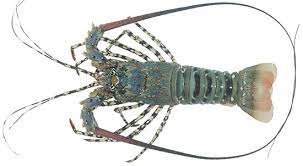Tropical Rock Lobster
Panulirus ornatus (Ornate Rocklobster)
Other Panulirus species except P.cygnus

Species
Rock Lobsters
Description
Available wild-caught, these marine crustaceans have the widest distribution of all Australian Rock Lobsters, found from Margaret River, WA, around the northern coast of Australia down to the Central Coast of NSW, usually in shallow water (less than 20m) on rock and coral reefs, although they can be found at over 100m. They are mainly caught in Torres Strait, by spear or hand (as they rarely enter pots), with the fishery jointly managed by Australia and Papua New Guinea.
Their body colour varies, but is often brightly patterned (especially on legs), their antennae are extremely long and the flagella on the long antennules between the antennae are also long and forked. Ornate Rock Lobsters are the main commercial Tropical Rock Lobster and the largest, they are often found on sand or mud. Rock Lobsters are mostly active after dark and are carnivorous scavengers, feeding on bottom-dwelling invertebrates.
Other Names
Coral Crayfish, Doublespine Rock Lobster, Green Crayfish, Ornate Rock Lobster, Painted Crayfish, Rock Crayfish, Scalloped Lobster, Tropical Spinylobster.
Family
Palinuridae (Spiny Lobsters).
Season
Mainly available from March to October.
Size and Weight
Commonly 350g-1.5kg and 7.5-11cm.
Price
High priced.
Relations
Eastern Rock Lobster, Southern Rock Lobster, Western Rock Lobster, Champagne Lobster.
To Buy
Sold whole and as tails. Look for brightly coloured, firm, intact, lustrous shells, without any discolouration, particularly at joints, and a pleasant fresh sea smell. If possible buy live, avoid green (raw, dead) Rock Lobsters (except for frozen tails) as it’s hard to tell how long they’ve been dead.
To Store
Live crustaceans should be consumed as soon as possible after purchase. Place in a container lined with damp paper, cover with damp paper or cloth and keep in a cool part of the house for up to 2 days, keeping the lining and covering damp. Wrap dead Rock Lobsters in plastic wrap or place in an airtight container. Refrigerate for up to 3 days or freeze for up to 3 months below -18ºC.
To Cook
Average yield is 35% of total weight (almost entirely in the tail) and up to 45% in small specimens. Has a sweet rich flavour, low oiliness and moist, medium-firm flesh, which is translucent when raw and white with orange tinges when cooked. Leg meat is often a little sweeter than tail meat. Shells turn red when cooked. The most humane, and easiest, method of killing any crustacean is to chill it in the freezer for about 45 minutes until it becomes insensible (but not long enough to freeze it). Once chilled, it should be killed promptly by splitting in half. See NSW Department of Primary Industries and RSPCA for more details.
Cooking Methods
Steam, poach, deep-fry, pan-fry, stir-fry, bake, grill, barbecue, raw (sashimi). Tropical Rock Lobsters are considered the best Rock Lobsters for sashimi. The firm flesh holds together well during most cooking methods.
Undercook, rather than overcook, them, as they will continue cooking in the residual heat; overcooked Rock Lobster will become tough and leathery. The carapace can be used to flavour stocks, soups and sauces.
